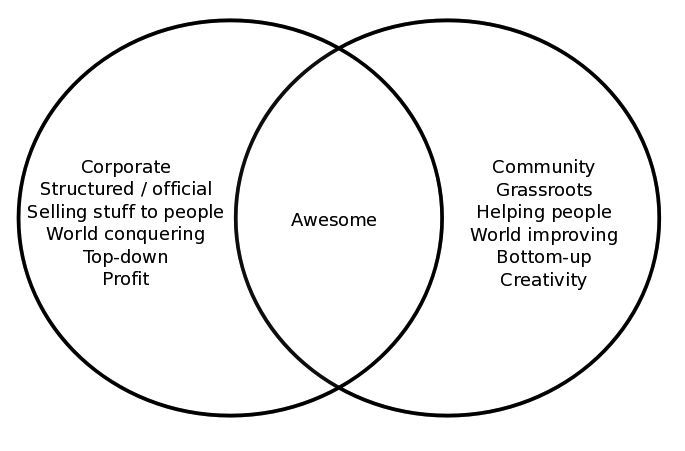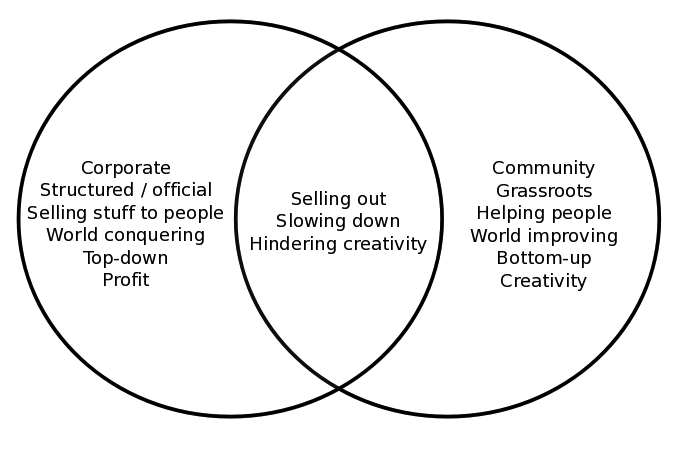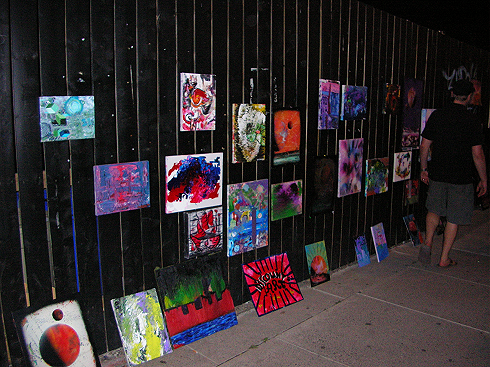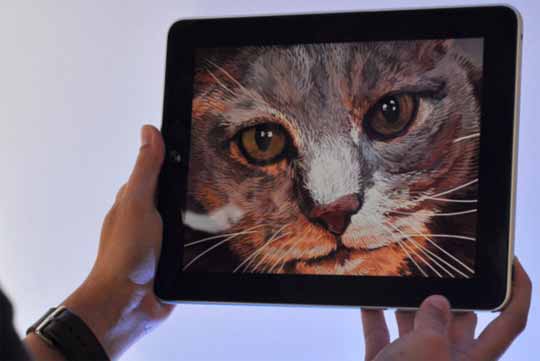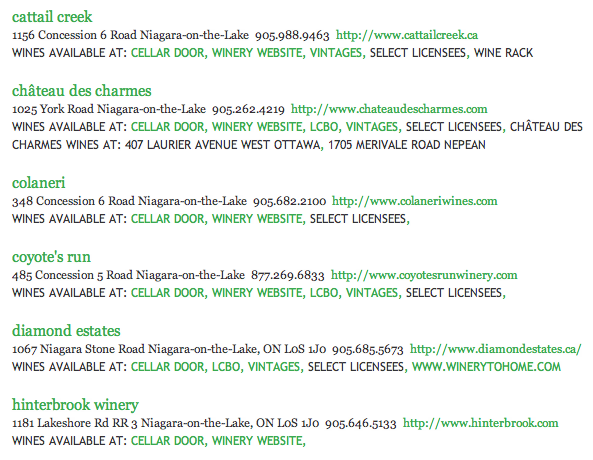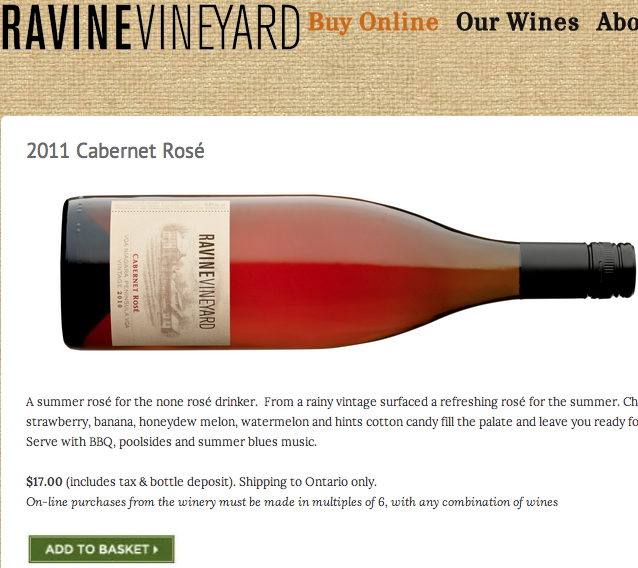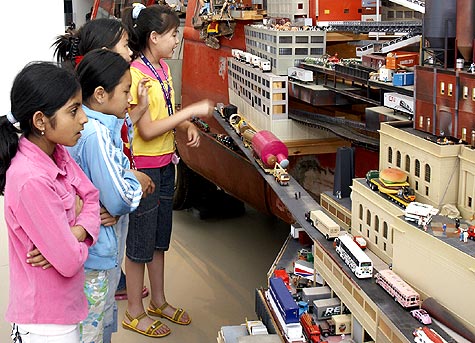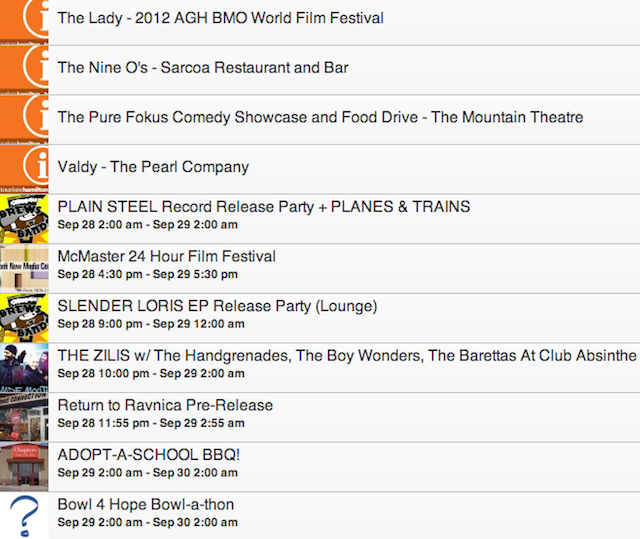Opportunity for Hamilton art and tech?
Part two of a two part series on art and technology in Hamilton. Part one is focused on current intersections between art and technology and is posted here, part two is focused on a potential opportunity.
In part one I mentioned how much of the technology industry involves intersections with existing industries. Mohawk College’s annual AppsForHealth (@AppsForHealth) conference and MEDIC Centre is a standout local example. In recent times art and culture have played an important and increasing role in an evolving Hamilton, which makes me think about what synergies may exist there, not so much at the level of using technology to produce products (video web series, digital animation, etc), but synergies in terms of developing new technology (software, apps, websites). The video game industry is my first thought, but this article is about another potential opportunity.
Creativity and organic community vs getting paid and structure
In the software world, many of us obviously want to be employed or make money based on our skills. But we also have things like the open source movement and hackathons, sometimes these things are about making money, but many times they aren’t. Sometimes it’s more about creating something for the love of creating something, or helping the community (think Random Hacks of Kindness). The kind of stuff Richard Stallman and others in the hacker subculture would probably like. There’s a tension between the more creative, communal hacker ethic and the need for structure, and to get paid. When one of my good buddy’s left for Microsoft, she got a good-natured ribbing from the rest of us about “selling out” to the corporate gig and the “evil empire”.
It’s possible to do both though, and achieve a special kind of full-spectrum awesome in the process. You can help people and improve the world around you while monetizing what you do, which gives you the money to grow and help more people and further improve the world, in a really great positive feedback cycle. As a result many companies, especially the really great companies, strive to do both – even the “evil empire” Microsoft will sponsor things like Random Hacks of Kindness.
But when you strive to do both, if you’re not careful you can end up slowing down, or selling out and crossing lines too. That Venn Diagram above has an evil twin below! There is research showing that unpaid volunteers in a charity donation drive outperformed paid volunteers (Pay Enough Or Don’t Pay At All [pdf]) and that a focus on monetary incentives can have a detrimental effect on tasks involving creativity (Large Stakes and Big Mistakes [pdf], or watch this TED Talk). So when dealing with creative endeavours such as technology and art, in the wrong situations a focus on monetization and structure will hinder quality, growth and the creative process.
Because I’m in software, even though there may be ongoing debates and it may depend on the situation, I have some idea where the lines are drawn for us between the creative process and getting paid. With the art world, I don’t really know where the lines are drawn. I’m an audience member, a viewer and a listener, but not a creator. I like stuff that makes me think, makes me feel something, sounds good or looks cool. That’s my whole experience with art. So I mean this as a constructive suggestion, and if I get anything wrong or cross any lines when discussing monetization and whatnot it is unintentional. For what it’s worth I consulted with friends who are involved in the art and creative community and have incorporated their feedback as best as I could.
Hamilton art and cultural goods should be sold online
Every time I go to an art crawl I see people selling all kinds of physical art and creative products, not just in the galleries themselves, but along the sidewalks, alleys and storefronts as well. I’ve never made a major purchase (i.e. hundred or thousand dollar paintings), but in addition to some smaller purchases I’ve also found it’s one of the best places to buy a unique gift for somebody. When you buy somebody a gift it’s pretty cool if it’s something that’s been handmade, that you’ve hand picked, and/or something you can’t get in a store.
But once the art crawl is over, unless it was something I bought in one of the permanent stores or galleries, I wouldn’t know how to buy something like it again, except by going to another art crawl. It’s happened to me where I see something and decide at the time not to buy it, but then the next day or next art crawl I can’t find it again. Even if it’s something I can go back to a permanent store or gallery on James street to buy, what if I didn’t live in Hamilton? What if I drove from Waterloo/Toronto/London for a night and went back? What if I want to tell my friends in another city, or country, about something I bought or an artist’s work or some kind of unique cultural product that I like so they can buy something similar too?
This is why I every time I go to an art crawl I think Hamilton artists/creatives/makers should start selling their work online. In terms of visual art, when I go through the listing of galleries on artshamilton.ca (and sublists of artists that I can find in the galleries), I can’t find a way to easily buy the artist’s work online. In a lot of cases I can see nice images of the art in what is basically an online gallery, and in some cases I see a price beside it, but in terms of buying the art it looks like I either need to contact the artist directly by e-mail or go to the gallery. And that’s just looking at the art galleries and artists, never mind all the antique, hand-made or knickknack type of items that I see along the street during an art crawl.
Now looking at how selling art has faired thus far online, back in 1999 artnet tried to pioneer the concept of online art sales but lost millions as part of the broader dot-com bust. Let’s keep in mind that 1999 was an era of dial-up Internet access with speeds a fraction of what they are now, using CRT monitors with “OK” SVGA resolution, attached to expensive clunky desktop computers with a mouse/keyboard interface. Oh, and a 2.74 megapixel digital camera costed $6,000. Those sorts of capabilities aren’t really conducive to an enjoyable online art purchasing experience.
Fast forward to 2012 and we’re living in a completely different era. Broadband Internet access at home and fast wifi and mobile Internet access have become ubiquitous. Our smartphones come with high resolution digital cameras. We have $500 iPads with retina displays, which have an intuitive pinch-to-zoom touch gesture interface that is perfect for viewing art. Therefore it shouldn’t be too surprising that there has been a recent boom in online art sales. Artnet itself is now doing a lot better, selling 6,500 pieces for $12 million in sales as of 2010.
There’s many different ways of selling art and related products online, one of the most successful is Etsy (@Etsy). Etsy is an online marketplace for buying and selling art, vintage and handmade items. Etsy allows sellers to setup standard online shops very easily, but there is also an Etsy API that allow developers to treat Etsy as a platform on which to build more sophisticated customizations. In May 2012 Etsy sales reached $65.9 million, up 68.5% from May 2011, with over 3 million individual items sold. That’s some serious exponential growth, and Hamilton should have a piece of that action!
When I sent this article to the artists and gallery owners that I know, I was told that art is a tough business, that selling higher-priced items can be a matter of building a reputation and clientele, and that there is a subjective element in terms of the work connecting with the buyer. Art galleries can do an amazing job at improving a neighbourhood, create social and community-building benefits, and generate economic activity in the surrounding area. But often the artists themselves don’t directly capture the benefits of that economic activity, it’s the services/events (restaurants, bars, live music, plays, comedy) and the related physical cultural goods (e.g. hand-made crafts, speciality spices, soaps and teas, etc.) that really benefit the most. This Bay Observer article about the potential for gentrification on James North seems to echo that sentiment.
That’s why I think it shouldn’t just be about selling art online, it should be about selling all “cultural goods and events” online. Hopefully in the process of doing so it should get more eyeballs on the more expensive art, and more chances for buyers to have a subjective connection with it and buy it too. I’d define cultural goods to be physical goods in the realm of paintings, sculptures, photography, hand-made crafts and clothing, speciality goods, etc, and a cultural event to be things like stage plays, live music and stand-up comedy. All those great things that you can’t find in an Ancaster Meadowlands-type power centre but that make being in downtown Hamilton awesome.
Hamilton cultural goods and events should become a global brand
The James North art crawl started up in 2005 when the street’s art community decided to increase awareness of their art scene by opening their gallery doors on the same night. This decision to work together gave them a critical mass and spurred growth that we are still seeing play out in 2012 as the art crawls continue to get bigger and more artists join in to showcase their work. I think the idea of the community working together to achieve critical mass and spur growth could now be extended to the (much lager) online marketplace.
For an example of what I mean, check out the “hub” website for The Wineries of Niagara-on-the-Lake. You can get a listing (Wineries -> Buy Wine) of all the wineries where you can buy wine in one click:
The websites for the wineries themselves are for the most part gorgeous looking and well functioning in terms of usability. You can sort through the collection of each winery and and buy bottles or cases of wine as easily as you could from any modern e-commerce website.
Working together online has helped make Niagara wine become a global brand (from the website: “visit us and see why we’ve grabbed the world’s attention”).
I see Niagara wine tours as playing a similar function to Hamilton art crawls, gallery tours, live music and stage plays. They bring people into the region to “sample the collection” in a fun way, and they spread awareness. But I think it’s brilliant how Niagara has also worked together on this “online hub” for searching through the wineries and buying the wine you sampled later on.
Hamilton cultural goods and events should have an online hub
Hamilton cultural goods and events should have a similar online hub made primarily for those willing to sell their tangible goods and market their events online. It shouldn’t be a website aimed at the community, it should be a website aimed at the cultural event attendees, the cultural good buyers, and people who have just heard through word-of-mouth that Hamilton has a growing cultural scene. The online hub could point to the online storefronts of whatever galleries, stores and/or artists that are selling their work online. Creating basic online storefronts for selling cultural goods wouldn’t be as difficult or expensive anymore thanks to modern tools like Etsy. Like the art crawl itself it would take a good base of willing participants to get started. As more galleries, stores and/or artists create online storefronts they could be added to the listing. It wouldn’t have to be limited to James Street, it could be for all cultural goods in Hamilton.
I believe that once an online hub is setup, the critical mass offline that we already see with the art crawl and especially the supercrawl could be translated into critical mass online. For an example of how this can happen, check out the story of #etsyday. Earlier on in the days of Etsy the sellers themselves banded together to create awareness of Etsy with grassroots “Did you Etsy today?” signs being placed all over and a push to make #etsday trend on Twitter. The art community and broader community in Hamilton could help make a similar awareness push online/offline to spur growth and sales.
There is a very powerful story in the revitalization of Hamilton with art as a driving force. That story is something that could resonate with communities around the world that are transitioning from an industrial economy to a creative economy. I’ve heard Hamilton art described as honest, fun to be around, and lacking pretension. That’s the kind of inclusive and welcoming image that if fostered correctly could help Hamilton cultural goods connect with more people and get into more homes.
I think an equally important component of such an online hub would be the marketing of Hamilton cultural events that bring people into the city to see just how much we have going on here. We have 11 million people within a 2 hour drive of Hamilton, all of them are a potential market for plays, dance, stand-up comedy, and especially live music. But how do we best gather all of that activity together and use it to pull in outsiders?
Many people have created an online presence of some sort aimed at letting people know just how much is going on here. Some examples:
Secret Hamilton (@SecretHamilton)
Happening Hamilton (@happeninghamilton)
Best of Hamilton (@bestofhamilton)
Beaux Mondes (@beauxmondes_)
Raise the Hammer (@RaiseTheHammer)
Get Cultured (@GetCulturedMac)
This Must Be The Place (@ThisMustBeThePlace)
MyHamilton
Mac Pop the Bubble
I Heart Hamilton
View Magazine
Two of the most interesting approaches that I’ve seen recently were demoed at DemoCampHamilton8 – Eventity (@Eventityca) by Steve Veerman (@veerman) and Hamilton Times by Dwanye Ali (@interestica) and John Fink (@adr). What I find interesting about these approaches is that they both involve (Hamilton-built) software innovations to conglomerate events into a common calendar.
Eventity provides a centralized way to search for events from sources such as Facebook, Tourism Hamilton, Tourism Burlington, View Magazine, SNAP Hamilton, Hamilton News, and Kijiji.
Where as Hamilton Times is aiming to be a collaborative open-data repository of public events for the city of Hamilton. A centralized pool of accessible data allows sites, individuals, researchers, and developers to make use of only what they require, while novel ingest methods aim to lower the technological barriers to participation.
What I like about these more technological approaches to event aggregation is that they drastically lower the burden and cost of gathering together all the activity into a common calendar. Perhaps some of this technology or some of these ideas could be adapted into a calendar of cultural events in Hamilton as part of an online hub, both lowering the cost barrier of creating a common calendar and increasing the calendar’s breadth and usefulness. Pulling in outsiders from the broader region to cultural activities in Hamilton, not just the art crawl but also things like Hamilton 24 (@thehamilton24), Fringe Festival (@HamiltonFringe), and live music shows, can perhaps (playing that role of Niagara wine tours) get them to buy more cultural goods from Hamilton too!
What’s in it for Hamilton tech?
I wrote this article last week about how e-commerce in general could be a Hamilton strength. My reasoning was that we have cheap space, a good location, we’re strong with community building and social media, the web design talent is there, McMaster has some research strength in this area, and that startup capital requirements are low. My other big reason was that the trail has already been blazed, in that we have seen Mabel’s Labels (@mabelhood) go from four (female) co-founders in a basement to 40+ employees in a 14,000 square foot location over the last 10 years. Mabel’s Labels sells personalized labels, mostly targeted at mother’s for household use. It’s a product that’s innovative and involves technology, but there’s definitely a creative element there as well.
If creators started making storefronts en masse using Etsy and other platforms, plugging into an online hub for Hamilton artists, there is the potential for some other breakaway success stories. Once you have success and customers, you have the desire to improve performance and take into account customer feedback.
This is where technology jobs can be created. So for example Etsy storefronts can be customized with Etsy Apps which are built by software developers. Getting off the Etsy platform, or other storefront type platforms like Shopify, is another option that requires software development. If a handmade product begins to sell in significant enough quantities online, it may warrant automizing production of the product as Mabel’s Labels does, which again adds technology jobs. In fact, about 1/4 of Mabel’s Labels 40+ employees work in IT!
Could this really work?
Like I said earlier on, I’m a software guy, not an artist. I’m worried about miss-communicating when writing this article because I don’t really understand the community. I think this idea is feasible, but that’s because of my own perspective.
Is it insulting for me to suggest that Hamilton artists make Etsy and other storefronts en masse? Do makers and creators have the time for managing an online storefront in addition to creating their work and selling it offline? Who would manage such an online hub? Is it super lame to suggest a “global brand” for Hamilton cultural goods and events given the organic, open and community-driven nature of something like the art crawl? What is the right balance between structure and getting paid vs creativity and organic community?
I don’t know the right answers to these questions. I think selling cultural goods and events online is something that should be led primarily by artists, creators and makers. I’ll say this though, as far as I’m concerned the cultural community is always welcome to connect with the technology community in Hamilton so that the right answers to those questions can be found. You’re always welcome at DemoCampHamiltons, StartupDrinks, etc.
The art crawl has made James North and Hamilton a better place by bringing enough artists together to reach thousands of people every month. Enough sparks were gathered together to create a fire of activity that’s improving a street and a city. I think bringing Hamilton cultural goods and events together with an online hub could spread that fire online and improve the world by reaching a market of billions.
